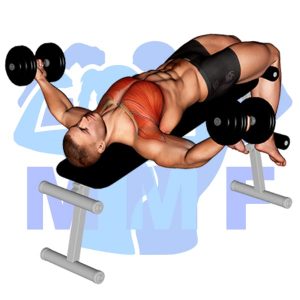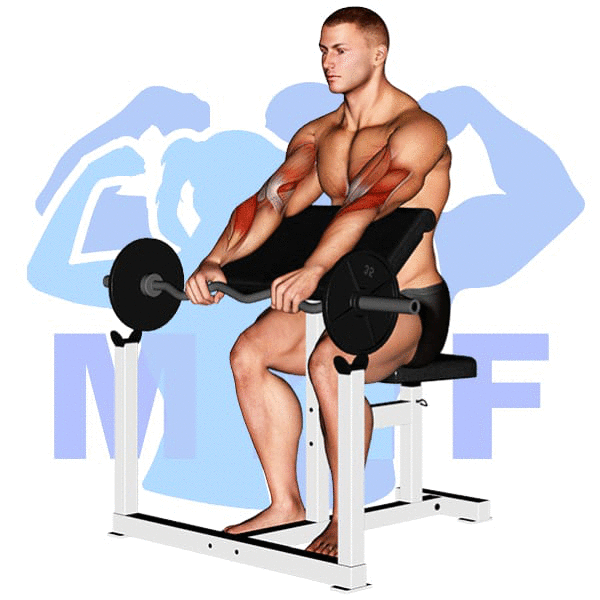Are you tired of not feeling the burn in your lateral raises with bands? You’re not alone. Many people struggle to activate the right muscles during this exercise, which can hinder their progress and discourage them from continuing. Don’t worry though, the cause of this problem is often due to lack of knowledge on proper technique or muscle engagement. Fortunately, the solution is simple and achievable with a few adjustments and tips. In this blog post, I’ll guide you through the most effective ways to perform lateral raises with bands and maximize your results.
Lateral Raises With Bands Summary
- Primary Muscles: Deltoid – Lateral
- Secondary Muscles: Deltoid – Anterior, Serratus Anterior, Supraspinatus, Trapezius – Lower, and Trapezius – Middle
- Equipment: Resistance Band
- Mechanics Type: Isolated
- Force: Push
- Utility: Auxiliary

Lateral Raises With Bands Instructions
- Start out with by straddling the back with it under your feet and one handle in each hand.
- Next with your arms hanging at your side and the band tight raise the bands up by lifting your arms and making a cross out of your body.
- Then, slowly lower your arms back down to your side.
- Keep executing these raises to complete a set.
Video Tutorial
Lateral Raises With Bands Muscles
Target (Agonist)
Synergists
Dynamic Stabilizers
- None
Stabilizers
- Levator Scapulae
- Trapezius – Upper
- Wrist Extensors
Antagonist Stabilizers
- None

Benefits of Lateral Raises With Bands
The lateral raise with bands is an effective exercise for building strength and size in the deltoid-lateral muscle. It works the deltoid-lateral muscle by requiring it to resist the tension of the band while you lift your arms outward. This resistance helps to build strength and size in the muscle. Additionally, this exercise can be performed with minimal equipment, making it easy to fit into any strength training or fitness routine. It is also a great way to target the deltoid-lateral muscle for better overall shoulder health and stability.
Tips for Performing Lateral Raises With Bands
Lateral raises are a great way to get fit and improve shoulder strength. With bands, you can take your lateral raises to the next level and see great results. To help you make the most out of your lateral raises with bands, here are some tips to keep in mind.
- Ensure that the bands are tight in the down position so that you have resistance throughout the movement.
- To increase the resistance you can step on more of the band. Remember to keep the resistance the same for each arm.
- If you find yourself bending over, stand with your back against a wall.
Benefits and Tips Video
Frequent Mistakes To Avoid
It’s important to practice proper form when performing lateral raises with bands in order to get the most out of your workout. To help you reach your fitness goals, it’s important to avoid common mistakes that can decrease the effectiveness of this exercise and even lead to injury. Below is a list of mistakes to avoid when performing lateral raises with bands.
- Don’t relax your abs. Flexing your abs protects your backbone by maintaining your internal pressure.
- You’ll Do Better Not To Cut Your Warmup. getting the blood flowing to your Muscle tissue is the best way to avoid injury.
- Don’t Make It To Easy. The only way to build muscle will be to challenge yourself.
Find More Resistance Band Exercises Here
Variations and Complementary Exercises
There are a variety of exercises you can do to target the same muscles as Lateral Raises With Bands. Whether you’re looking for variations, complementary, or alternative exercises, the following list has something for everyone.
Lever Lateral Raise (Machine)

The Lever Lateral Raise (Machine) is a great alternative or complementary exercise for Lateral Raises With Bands. This machine provides adjustable resistance, allowing you to customize the intensity of the exercise to suit your fitness level and goals. The Lever Lateral Raise works the same muscles as the Lateral Raises With Bands but with less stress on the shoulders, making it an ideal choice for those who suffer from shoulder pain or have limited range of motion in their shoulders. Additionally, the Lever Lateral Raise helps to improve overall shoulder stability and strength, which can be beneficial when performing other exercises involving the shoulders.
Lying Dumbbell Rear Lateral Raise

The Lying Dumbbell Rear Lateral Raise is a great complementary or alternative exercise to the Lateral Raises With Bands. This exercise focuses on the rear deltoid muscles and can help to strengthen and tone them. To perform this exercise, you will need a flat surface and a pair of dumbbells. Begin by lying on your back, with your knees bent and feet flat on the floor. Hold a dumbbell in each hand and raise them out to your sides until your arms are parallel with the floor. Slowly lower the weights back down and repeat for desired number of repetitions. This exercise is a great way to add variety to your shoulder workout and build strength in your rear deltoids.
One Arm Band Lateral Raise

The One Arm Band Lateral Raise is a great alternative or complementary exercise for the Lateral Raises With Bands. This exercise focuses more on the stabilizing muscles of the shoulder, as you are using only one arm at a time. Additionally, the resistance from the band is adjustable, allowing you to challenge yourself at different levels. The motion of the exercise is similar to the Lateral Raises With Bands, where you are raising your arm up and out to the side. This exercise can be done with both arms at the same time or alternating arms for a more challenging workout.
Check Out These Top Resistance Band Exercises
Seated Dumbbell Lateral Raise

Seated Dumbbell Lateral Raise is a great complementary or alternative exercise for Lateral Raises With Bands. This exercise involves the same movement pattern, but with the added challenge of using weights. It works the same muscles as Lateral Raises With Bands but with the added difficulty of maintaining stability while lifting the dumbbells. This exercise requires more control and balance as you lift the weight, engaging more muscles in the shoulder and upper back. For an extra challenge, try lifting the weights to eye level or even higher. Seated Dumbbell Lateral Raise is a great way to add variety to your workout and target those important shoulder muscles.
Seated Dumbbell Rear Lateral Raise

The Seated Dumbbell Rear Lateral Raise is an excellent alternative or complementary exercise for the Lateral Raises With Bands. This exercise requires you to sit on a bench with a dumbbell in each hand and raise your arms out to the sides until they are parallel to the floor. This exercise targets the rear deltoids, which are often neglected during lateral raises. Additionally, this exercise helps to improve shoulder stability, as you must keep your elbows slightly bent throughout the movement. It also increases strength and size in the rear deltoids while developing shoulder stability.
Single Arm Lateral Cable Raises

The single arm lateral cable raise is a great alternative or complementary exercise to lateral raises with bands. This exercise can be done using a cable machine and requires the user to stand with feet hip-width apart, slightly bent knees, and arms outstretched. From there, the user will lift one arm up and out to the side until it is in line with the shoulder. This exercise works the same muscles as lateral raises with bands but the added resistance of the cable machine helps to increase muscle strength and endurance. Additionally, this exercise can be modified with different attachments to add more resistance.
Find More Shoulders Exercises Here
Opposing Complementary Exercises
To complete a full workout and ensure that all of your muscles are balanced and working properly, it is important to supplement the exercise Lateral Raises With Bands with exercises that target opposing muscle groups. Below are a few exercises that will help you do just that.
Decline Dumbbell Fly

Decline Dumbbell Flyes are an effective complementary exercise to Lateral Raises With Bands, as they work the opposing muscle group. The Decline Dumbbell Flyes target the lower chest muscles, while the lateral raises with bands target the upper chest and shoulder muscles. Decline Dumbbell Flyes involve lying on a decline bench with a dumbbell in each hand and performing a fly motion by bringing the weights together above your chest. This exercise helps to strengthen and define the lower chest muscles and provides balance to the chest muscles when combined with lateral raises with bands.
Decline Dumbbell Twist Fly

The Decline Dumbbell Twist Fly is a great complementary exercise to Lateral Raises With Bands. It works the opposing muscle groups in the shoulders, using both the anterior and posterior deltoids. This exercise allows for a greater range of motion as you twist your arms from side to side while lying on a decline bench. It also works the rotator cuff muscles, helping to increase stability and strength in the shoulder joint. This exercise is particularly effective in helping to prevent shoulder injury and improve overall shoulder strength and mobility.
Dumbbell Fly

Dumbbell Fly is a great exercise to pair with Lateral Raises with Bands, as it works the opposite muscle group. Dumbbell Fly works the chest, while Lateral Raises with Bands targets the shoulders. This combination of exercises works both the chest and the shoulders, allowing for a full-body workout. With Dumbbell Fly, you hold a dumbbell in each hand and then raise them up and out to your sides in an arc. This helps to build strength and definition in your chest muscles. Lateral Raises with Bands works the shoulders by performing lateral raises with resistance bands. By combining these two exercises, you can effectively target both the chest and shoulders for an effective full-body workout.
Get Those Shoulders Burning With Banded Lateral Raises!
Banded lateral raises are a great exercise to add to your shoulder workout routine. Not only do they help increase shoulder strength, but they also work on your stability and control. By adding resistance bands, you can target different parts of your shoulder muscles and increase the burn. Plus, the added benefit of using bands is that they are easily portable and you can do this exercise anywhere, whether it’s at the gym or at home.
References: Wikipedia | ExRx.net | PubMed.gov | Comprehensive List of Shoulders Resistance Band Exercises




